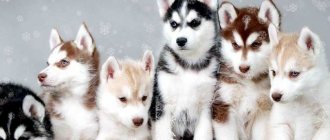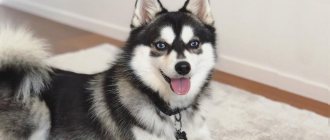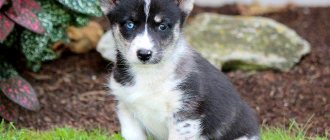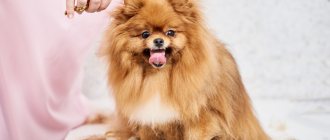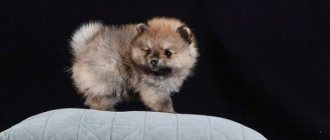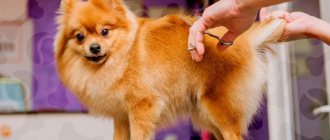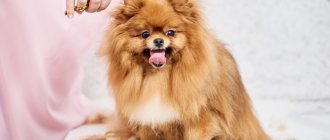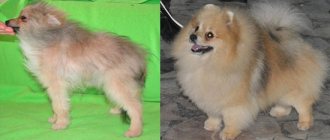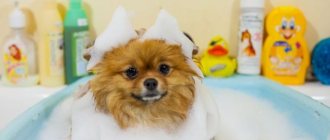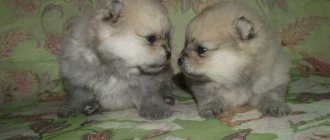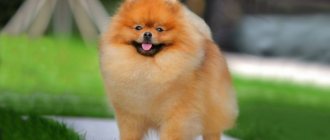Breed characteristics
| Short description | |
| Origin: | USA |
| Conditions of detention: | City apartment or house |
| Purpose: | Decorative, companion |
| Color: | Duplicate all husky colors |
| Wool length: | Up to 10 cm |
| Adult dog size: | Height from 25 cm to 40 cm; weight from 5 to 12kg |
| Average life expectancy: | 13 – 14 years old |
| Walk: | At least 2 times a day |
| Physical activity needs: | Average needs, active walks required 1 – 2 hours per day |
| Fédération Cynologique Internationale (FIC) classification: | The breed is not recognized by the FCI |
| Puppy price: | Reaches up to 300 thousand rubles |
Advantages and disadvantages
Despite the fact that the Spitz mix is an unrecognized breed, puppies born from such a mixture have distinctive features of appearance and character. The mixture has its advantages and disadvantages.
Among the advantages of an unrecognized breed are:
- beautiful appearance;
- easy training;
- attention to the owner;
- unobtrusiveness;
- goodwill.
The cross also has some disadvantages:
- regular grooming;
- the need for physical activity;
- tendency to howl;
- Possible problems with teeth.
History of the origin of the Pomsky breed
The history of the Pomsky as a breed is just taking shape. For the first time, photos of cute mestizos appeared on the Internet in 2013, from an American breeder . And after 4 months, a club for breed lovers appeared in the USA, but this did not help the Pomsky become an official breed. But in 2022, Spitz and Husky mixes began to appear on the European continent.
Pomsky is not recognized as a breed by any cynological association in the world.
The development of the breed is greatly hindered by the lack of standard and diversity of appearance in litters. Only kennels participating in experimental selection engage in breeding, and only 2 organizations recognize Pomskies - the American Hybrid Dog Club and the Pomsky Fanciers Club. But enthusiasts predict a great future for mestizos, as the fashion for small, photogenic dogs is now in full swing.
Distinctive features
There is no breed standard today. Hybrids differ significantly from each other in the variety of colors, sizes and constitution. In order to somehow streamline the “heterogeneity,” breeders have identified several types of Pomsky:
- Shorthair. It is very rare and is not in consumer demand. It has a hard and short coat, a slightly stretched and light body. Height up to 40 cm at the withers, weight up to 13 kg. The eye color and coats are completely similar to the Husky.
- Plush. The smallest and most popular of the subspecies is up to 25 cm at the withers, weighing no more than 6 kg. Visually very similar to a Spitz in Siberian Husky colors. May have blue irises or heterochromia. It has a thick, long coat with a very soft, dense undercoat.
- White. It is very rare, which is why the price of sobka is high. Height from 35 to 40 cm. Weight 12 – 13 kg. Moderately elongated format, thin bones, but strong muscles. Most often has blue eyes. The color is solid white, the nose is dark brown or black.
- Fox. Short stature (no more than 35 cm), elongated body, long smooth hair and fiery red color give this type a resemblance to a fox. The muzzle is long and pointed, just like that of its wild “relative”.
- Brown. Distinguished by the rich chocolate color of the coat and nose and blue eyes. It has a slightly stretched body and strong bones with developed muscles. Height 35 – 40 cm, weight up to 15 kg. The type of coat is similar to that of a husky - dense, thick undercoat, outer coat of medium hardness and long.
Dimensions and weight
The height of the Pomsky at the withers reaches a maximum of 40 cm, and the body weight of representatives of this breed depends on the generation of the litter and the weight of the parents.
So, dogs of the first generation weigh on average 4-12 kg, and of the second - from 4 to 10 kg.
Mixed breeds have pronounced sexual dimorphism - males are taller and heavier than females.
The approximate weight of an adult Pomsky can be determined by adding the weight of both parents and dividing the resulting figure in half..
Photo of an adult dog
Photos of puppies
Features of character and behavior
Since the Pomsky is just being formed, it is very difficult to say what character traits such a mestizo has. The genetics of mixed breeds are sometimes completely unpredictable. In one litter there may be one puppy copying the behavior of a husky, another will completely correspond to the behavior of a Spitz, and a third may have traits of both breeds.
In most cases, the behavior of an adult dog depends 100% on upbringing. Even the most notorious stubborn dog, with proper training, will become an obedient and flexible dog.
In general, Pomskies are sweet and friendly dogs, love children, and are not aggressive towards other animals. Thanks to their light bones, mestizos are very active throughout their lives - they are ready to run and play until old age. Owners need to be careful; when playing too much, a Pomsky may run after a cat or bird on the street.
In addition to being highly active, the genes of the Siberian Husky make Pomskys real little stubborn dogs. They need to be raised from childhood, gently but confidently, to achieve 100% obedience, otherwise there may be behavioral problems in adulthood. Also, without a splash of physical and mental activity, behavioral difficulties often arise - excessive barking, running away, chewing.
Pomskies are suitable for people with an active lifestyle and a strong spirit . They love long walks in the park and are happy to run after the ball, but are not always willing to give it up. It’s easy to stay at home alone, but only if the owner has had a good walk with the dog first.
Advantages
The main advantages of the Pomsky are:
- Beauty.
- Good health.
- Small sizes.
- Endurance.
- Good nature and cheerful disposition.
- Loyalty and love for the owner.
A separate point to note is that Pomskies can become excellent athletes in agility or flyball.
Flaws
Any medal has 2 sides, the main disadvantages of mestizos:
- Stubbornness.
- Tendency to escape.
- High price.
- Hyperactivity.
- Excessive barking.
A separate point is that there is too much variation in appearance options, and a complete lack of ability to predict the appearance of the litter.
Education and training
Training this charming and beautiful dog is pleasant and effective. He is smart, agile and energetic. He always wants to please his master with the successful execution of his command, and tries to obey. But, due to excessive emotionality, he may lose concentration and be distracted by extraneous noise.
We recommend having a whistle with you, which can be used to redirect the dog’s attention to you. Every time she turns her gaze away from you, whistle for her to turn around. Start learning basic commands with her, for example, “come to me” from the first months. The sooner you start training your pet, the more well-mannered and manageable he will grow up.
Don't let your mischievous Pomsky play around when it's inappropriate. His behavior can become destructive, especially if he grows up in an atmosphere of permissiveness. Each member of the household should be prepared to deny the dog play or attention, without fear of upsetting it.
Advice ! Scold your dog if he barks frequently for no reason. Loud, continuous barking irritates many people, and this mixed breed is very noisy.
Care and maintenance
In addition to good walking, Pomskies, like their parents, require careful coat care. Long hair and dense undercoat require attention - every other day you need to comb your pet with a wide-toothed comb to avoid the formation of tangles, and 1-2 times a week with a slicker brush to remove excess undercoat and dead outer hair.
During the spring-autumn period, grooming activities must be carried out daily. Or, once every 2-3 months, take the dog to a professional for “express shedding”.
In rainy and muddy weather, your pet will have to wash its paws and belly after every walk. Your puppy should be accustomed to bathing procedures and a hairdryer from early childhood, and be sure to praise him for good behavior in the bathroom. It is not recommended to completely wash your dog more than once a month . When bathing, be sure to use special veterinary shampoos and balms; human shampoos are absolutely not suitable for animals. Afterwards, dry with a hairdryer, without using hot air.
Otherwise, caring for your Pomsky is not a hassle:
- The claws are trimmed as they grow with special claw clippers or guillotines.
- Ears are cleaned no more than 2 times a month. After first soaking the dirt with a special lotion, then remove excess liquid and scabs with a cotton pad or swab.
- Eyes , as a rule, do not cause trouble with proper nutrition and do not require special care. If tearfulness is increased, then you should show the dog to the veterinarian.
Pomsky is a special breed and requires appropriate care. Otherwise, she would not have become an Internet star.
Nutrition
A small puppy requires a lot of time - you need to feed the baby:
- From 2 to 4 months at least 6 times a day (approximately every 2.5 - 3 hours).
- From 4 to 6 months 5 times a day.
- From 6 to 9 months 4 times a day.
- From 9 to 11 months 3 times a day.
- From 11 months until the end of life - two meals a day.
The portion and interval between feedings are gradually increased; the stomach of a small puppy is not able to digest a large amount of food at once.
Whether to feed your dog natural food or ready-made food is up to everyone to choose for themselves. But it is worth noting that balancing natural feeding correctly is quite difficult and expensive. Even super-premium food is cheaper than “natural” food (additional vitamins are needed).
We recommend that you read the article on the topic: “Porridge for dogs: recipes, do’s and don’ts, review of the composition and value of cereals.”
When feeding foods of natural origin, the diet must include:
- Muscle meat.
- Offal.
- Fermented milk products.
- Sea fish (boneless).
- Vegetables and unsweetened fruits.
- Eggs.
- Cartilage and tendons.
It is strictly forbidden to give dogs:
- Chocolate and other sweets.
- Sweet baked goods.
- Bones.
- Smoked or pickled foods.
- I eat with salt and spices.
- Sweet fruits or berries (grapes, watermelon).
There is an opinion among dog breeders that meat and fish should be given boiled - this is a wrong belief! The stomach of a predator is adapted to digest raw food. Meat components are subject to heat treatment only if there is a possibility of infection with helminths or infections.
Health
To date, the breed has not been thoroughly studied, but existing individuals have shown good health results. F1 hybrids have not been shown to be susceptible to genetic diseases found in Huskies and Spitz dogs. For the F2 and F3 hybrids, things are much worse with health, as well as with the exterior. It is for this reason that, at the moment, breeders have abandoned the idea of crossing second and third generation mestizos.
Vaccinations
Vaccination is an integral part of mandatory veterinary measures for each breed. The first vaccination is given after double deworming, usually at the breeder, at the age of 6 to 8 weeks . Revaccination is carried out after 3 weeks to finally form immunity to viral infections. In regions with a favorable epidemiological situation, veterinarians often immediately give a rabies injection along with a double vaccine. Otherwise, the rabies vaccination is postponed until the complete change of teeth . The last puppy immunization is done every year, and thereafter it is repeated annually along with rabies.
The veterinarian can adjust the vaccination schedule depending on the conditions in which the puppy is kept and his state of health. The serum is also selected by the veterinarian.
Until the end of all vaccination activities (and 2 weeks after), it is necessary to observe strict quarantine and keep the puppy away from other dogs. Modern serums do not require special preparation, except for the prevention of worms before each immunization. During the appointment, the doctor will examine the animal, measure its body temperature and, if everything is normal, immediately give an injection.
Modern medications used by veterinarians have virtually no side effects, and allergic reactions are extremely rare. Normally, the dog may be a little apathetic or lethargic. A small ball may form at the injection site, which goes away in 2-3 days. There may be a slight increase in body temperature, refusal to feed, and one-time vomiting. If the listed symptoms last more than a day, you need to show the animal to a doctor.
Important article on the topic: “Everything you need to know about dog vaccinations.”
Diseases
Spitz and Husky mixes are not prone to genetic diseases. But age-related changes do not bypass the Pomsky. The most common problems:
- Cataracts and retinal detachment.
- Dislocation of the knee joint.
- Diseases of the genitourinary system.
Otherwise, these are strong and healthy dogs, and all diseases appear only in old age.
Walk
The Pomsky is a very active dog and needs daily walks in the fresh air and active games. You need to walk your cute mestizo at least twice a day, and with puppies up to a year old up to 5 times a day. It is better to combine walking with fun runs for the ball or obedience classes. Mestizos prefer spending active time instead of a leisurely walk in the park.
Otherwise, the descendant of the primitive Spitz will endlessly bark, dig holes, run away or destroy the house. Undischarged activity results in nervous system disorders and destructive behavior at home.
POMSKY RUSSIA LOVELY PET
We are pleased to announce! Our Pomsky breed group has received initial recognition from 7 cynological organizations, and now has the right to be called an independent breed with an official standard! and take part in exhibitions! AUTHOR OF THE POMSKIE BREED IN RUSSIA - KUDRYASHOVA T.E. kennel "LOVELY PET", CO-AUTHOR OF THE BREED - ASTAKHOVA V.I. p-k "NORD SOUL". -ROO NKL, -ASRK NRKA, -ROO NSKTs, -DWCU (USA), - UCI "Good World", IKU SKOR-breed group, - WCHSA (Bulgaria)
We inform you that we managed to organize and register the Pomsky breed club "Russian Pomsky Club" / Russian Pomsky Club (RPC), which allows us to organize special breed exhibitions and Pomsky shows in Russia and abroad, as well as enter into partnership agreements with breeds Pomsky clubs in other countries. All members of the Association of Pomsky Owners and Breeders are also members of the Russian Pomsky Club. The rules for joining RPC remain the same as in POBAR
Pomskys were specially bred as a cute miniature companion. To do this, representatives of one fifth of the group were crossed - Pomeranian Spitz and Siberian Huskies. Small dogs with the characteristic appearance of a husky are often confused with other mestizos of this breed - the Alaskan Klee Kai and the Siberian mini husky.
In 2011, the famous breeder Teresa Peterson from Burnsville (North Carolina, USA), specializing in breeding huskies, became interested in the possibility of breeding a new breed, and after 2 years the first litter was obtained. At the same time, similar crossbreeding was carried out in Russia (Lovely Pat’s nursery, Moscow region). For two years, all the puppies received remained in the nursery for further breeding work, and for the next 3 years the best representatives were selected for the further formation of the breed.
Many breeders followed the example of Peterson and Kudryashova, and after some time there became a need for an organization that would monitor their activities. Thus, in 2013, the Pomsky Club of America (PCA) was organized, whose task was to maintain selection at a high level and the desire to achieve recognition of the Pomsky as an independent breed with its own standard, and in 2022, the Association of Pomsky Owners and Breeders in Russia-Pomsky was organized in Russia Owners & Breeders Association Russia – POBAR Pomsky Owners & Breeders Association Russia – POBAR
So far, Pomskies are not recognized by the canine societies RKF and FCI, and the activities of breeders are supported only by ROO NKL OPK KC STOUT (Russia), RCA and ASNS - American Hybrid Dog Club, DWCU-USA and the POBAR Association, which is a member and official representative in the Russian Federation , international organization Dog World Cynological Union "DWCU" (USA), UCI-International Union of Kennel Clubs Germany, IKU SKOR -International Kennel Union Union of Cynological Organizations of Russia-breed group.
In Russia, Tatyana Evgenievna Kudryashova has been officially engaged in the selection and formation of the Pomsky breed since 2013, at the POMSKY RUSSIA LOVELY PET nursery.
We are glad to welcome you to the website of the Lovely Pet nursery! Our nursery was founded in 2009. It is registered by NKPTS (Russia), DWCU (USA), DWKC (Great Britain), IKU SKOR (Russia), UCI Dobry Mir (Russia). He is also registered and is a member of the Association of Pomsky Owners and Breeders in Russia (POBAR). On the POBAR website you can view all officially registered nurseries participating in the breeding program for the formation of the Pomsky breed, familiarize yourself with the breeding status and general pedigree database https://pomskypedigree.ru/pomsky
By visiting the pages “our graduates” and “our producers”, you will be able to get acquainted with the dogs of both the kennel itself and the dogs of our breeding living in their new families. On the “news” page you will find information about upcoming exhibitions, as well as about the births of new litters. On the Pomsky Puppies page you will find all the information you need about the puppies for sale.
Be sure to read the very important information about the conditions for purchasing and reserving puppies in our kennel on the “conditions of purchase” page. Next, you can study the conditional standard of the Pomsky breed group.
The main direction of our nursery is the formation of the Pomsky breed and the consolidation of breed genetic characteristics. Due to the fact that the breed is new and little studied, it does not have an approved standard, but based on the genetic data obtained by the breeder by hybridizing two breeds, each nursery has a conditional standard.
POMSKI STANDARD
Country of origin: Russia, USA
Purpose: companion dog
SKOR-IKU classification: 5 group “Companion dogs” without working tests
General appearance: a medium-sized, active dog with a lively temperament, strong build, with moderate (not light) bones, sexual dimorphism is well expressed. Spitz-shaped with the color of a Siberian Husky.
Behavior and character: highly trainable and completely people-oriented. The dog is quite energetic, but not willful like a husky. Does not require much physical activity, but can be used in sports. Grooming is minimized. Stress-resistant and suitable for keeping in urban environments.
IMPORTANT PROPORTIONS:
When viewed from the side, the length of the body, measured from the humeroscapular joints to the ischial tuberosities, is slightly greater than the height of the dog at the withers;
The length of the muzzle from the tip of the nose to the stop is equal to the length of the skull, measured from the stop to the occipital protuberance.
Head : proportional to the body.
Skull : Medium in size, proportional to the body, slightly rounded and tapering from the widest point to the eyes.
Stop : Well defined.
Disadvantages: small lightweight or excessively heavy head; flat back of the head.
Faults: too small or very heavy head, not triangular in shape.
FACIAL PART OF THE SKULL:
Muzzle : straight, of medium length, in proportion to the skull, well filled and fairly wide, tapering slightly towards the nose; The ratio of muzzle to skull is approximately 1:1. The lips are well pigmented, close fitting and match the color of the nose.
Disadvantages: muzzle too narrow or wide and heavy.
Faults: muzzle too short or long
Nose a: medium size, clearly defined. Acceptable nose color: black for gray, fawn, white or black dogs; brown in brown and fawn dogs; may be flesh-colored in pure white dogs. A “snowy nose” (with pink streaks) is allowed.
Disadvantages: partial pigmentation of the nose
Jaws and teeth : jaws are normally developed, bite 6x6 with full closure, scissor bite with full dental formula
Disadvantages: straight bite, missing one or two teeth
Defects: overshot, undershot, misaligned jaw, missing more than 2 teeth
Cheekbones : softly rounded, not prominent
Eyes . Almond-shaped, moderately wide and slightly oblique. Eye color is brown, green or blue, eyes of different colors and partially different colors are acceptable
faults: too obliquely or too closely set, non-mendala-shaped.
Ears : triangular in shape. medium size, close upright, positioned high on the head
Faults: wide-standing, rounded, too small or too large in relation to the head
Defects: hanging or semi-hanging, soft cartilage
Neck : medium length, without dewlap, set high. When moving at a trot, it stretches out and brings its head slightly forward.
Disadvantages: slight deviations from the above
FRAME
Back : straight, strong, of medium length. The top line is smooth and straight.
Faults: slightly arched, sagging back, not straight topline
Tail : pubescent, when the dog is in a calm state, the tail is hanging, long, the tip of the tail reaches the protrusion of the hock joint; when the animal is excited, the tail is bent over the back in the shape of a sickle or lies on the back, it can be lowered to the side in the form of a half ring;
Disadvantages: high and straight tail, tightly curled tail.
Chest : Deep, well arched, but not too broad. The ribs are slightly flat to allow the dog to move freely. The muscles and ligaments attaching the shoulder to the chest are strong and well developed.
Faults: chest line just above the elbow, too wide or narrow chest, rounded (barrel-shaped) or too flat ribs
LIMBS
Forequarters : When viewed from the front, moderately spaced, straight, parallel and plumb. The shoulder blades are directed obliquely back, long, with well-developed muscles and fit tightly to the chest. The length from the elbow to the floor is slightly greater than the distance from the elbow to the top of the withers. Removal of the fifth finger is allowed. The elbows are strong and fit well to the chest. The forearms are straight, of medium length in relation to the body. The pasterns are strong and slightly sloping. The paws are well assembled, the toes are of medium length.
Disadvantages: straight shoulders, weak ligaments, slight deviations from the above.
Hindquarters : Muscular, parallel when viewed from behind. Thighs moderately muscular. The length of the thigh is equal to the length of the lower leg. The knees are strong, moderately arched, clearly defined, and do not turn outward or inward when moving. The hocks are perpendicular to the ground and strong. The corners are quite pronounced.
Disadvantages: all deviations from the above
Movement : moderately fast trot. When viewed from the front one step at a time, it does not form a simple path. As speed increases, the limbs gradually tilt inward so that the paw prints line up along the longitudinal axis of the body.
Leather : fits tightly to the body, does not form wrinkles
WOOL
Two types are allowed - elongated (fluffy) and classic (medium length), double with thick undercoat, straight guard hairs;
Fault: too short or long shaggy coat, lack of undercoat.
WOOL COLOR
black and white, gray and white, silver and white, fawn and white, brown and white, black and white with tan, brown and white with tan, solid white.
It is mandatory to have masks typical for the Siberian Husky breed.
GROWTH , height at withers
Standard: 40-45 cm
Mini: 35-40 cm
Toy: 30-35 cm
VICES
Defects in build, head too flat or apple-shaped, not pure color, square body format.
DISQUALIFYING FAULTS
- aggressiveness or cowardice;
-unclosed fontanel;
-overshot or undershot;
- solid coat colors - black, brown (agouti), red, fawn, sable
- white-spotted (peebold), - solid colors with white markings,
- black and tan with white spotting (less than 30%) and - brown and tan with white spotting (less than 30%),
-merle,
-black and tan, -brown and tan
-fawn-white combined with brown eye color,
- solid white combined with brown eye color.
NOTE : Males must have two apparently normally developed testes, fully descended into the scrotum.
A COMMENT:
The Club dog handler/kennel manager is given the right to independently evaluate and cull the puppies of the litter.
If for some reason, in the absence of shortcomings and defects, the club dog handler/kennel manager has decided not to admit one or more puppies into the breeding program, he has the right to make an appropriate note in the puppy’s metric and general litter card. When exchanging such a metric for a certificate of origin (pedigree), it will be issued with the stamp “Without the right of breeding use.” Such a dog can participate in exhibition events, but does not participate in the breeding program.
FEATURES OF BREEDING
One of the most discussed questions is: how do matings occur between miniature Spitz dogs and fairly large huskies? Internet users have a lot of versions on this matter. In fact, the breeders do not place any stools and do not tie the dogs to anything. In most cases, Pomsky breeders obtain Pomsky puppies by artificially inseminating a Husky female with the sperm of a Spitz male.
CONTENT FEATURES
Due to their small size, Pomskies can be kept in an apartment. It is advisable that the dog has its own sleeping place, bowls and several toys. Pomskys love to be the center of attention and be close to their owner, but at the same time, these dogs can easily tolerate forced loneliness and feel great both in a large family and in a quiet home with a single owner.
CARE
Pomskies are not a hypoallergenic breed and shed quite heavily, usually the first age shedding and subsequent seasonal ones twice a year. During shedding, the dog needs to be brushed regularly. Bathe your dog no more than once a month. It is also necessary to ensure that the ears and eyes are always clean. The claws are trimmed as they grow, once every 3-4 weeks. You can feed your Pomsky both natural food and ready-made industrial food. It is advisable to walk your dog 2-3 times a day for at least an hour.
HEALTH
Pomskies, as a rule, do not inherit diseases characteristic of the original breeds. This is largely due to the effect of heterosis, which is also called hybrid vigor. In other words, this is an increase in the vitality, fertility and health of hybrids compared to the parental forms. Of course, Pomskies can get sick, but more often the diseases are caused by poor care or nutrition. The Pomsky's lifespan is estimated to be 13-15 years. (the oldest individuals in Russia today are 7 years old).
Mating
Since the Pomsky is actually a cross between a Spitz and a Siberian Husky, second and third generation hybrids are not mated to each other. Only the first generation of mixed breeds are considered true Pomskies . Subsequent hybridization leads to fragmentation of genes, and the puppies turn into ordinary “mongrels”, losing all the exterior attractiveness of the breed.
Mating is carried out only in specialized nurseries of hybrid dogs, through artificial insemination. In order for the gestation of puppies and childbirth to take place safely for the litter, parental roles are distributed as follows:
- The mother is a female Siberian Husky.
- Father is a male Spitz.
At home, without special equipment for artificial insemination, it is impossible to breed a Pomsky.
Read a detailed article on the topic: “Everything you need to know about breeding dogs: appropriate age, what to do if it doesn’t work out, rules and tips.”
Tips for choosing
To avoid getting a sick animal with pathologies, it is better to buy a puppy from nurseries. It is necessary to carefully select both the breeder and the puppy.
It is better to meet with the owner of the nursery in person after a correspondence conversation by phone or Internet and discuss all the details. You should evaluate how well the animals are kept and how the breeder answers questions. Dirty enclosures, unkempt and sick dogs should alert you. It is better not to have anything to do with a breeder who avoids direct answers to simple questions (when to breed, look at the pedigree and medical records, what to feed).
It is necessary to make a choice not only in favor of the most beautiful puppy in the litter, but also the most active one. You should pay attention to several features of the baby:
- the coat is clean, uniform, thick;
- eyes without discharge or clouding;
- the tummy is proportional to the body, not bloated;
- ears look up, not widely apart;
- the puppy is active, curious, makes contact easily, does not show aggression;
- skin without inflammation;
- the ears are clean, without suppuration.
It is worth remembering that buying a cross without a pedigree is a big risk. For decent money you can get an unbalanced pet with health problems. Pomsky is a charming baby who will become a full-fledged member of the family. Choosing the right puppy and regular care will help avoid health problems. Love, attention, care will make the dog truly happy.
Key points in training
It is necessary to raise the descendants of primitive Spitz dogs from the first day they appear in the house. Mixed breeds have a rather stubborn disposition, but in puppyhood they are quite easy to control. Training must be done with positive reinforcement, otherwise the Pomsky may completely refuse to follow commands.
Pomskys use their favorite toy or treat as motivation.
From the husky, the breed inherited a tendency to run away, therefore, unless you have achieved 100% obedience from your pet, it is not recommended to let it off the leash. Training should be short but daily. It is better to practice 1 command for 5 minutes, but 3 – 4 times a day. This way the puppy doesn’t get tired of the activities, and working with the owner becomes much more interesting.
Despite its miniature size and pretty face, the Pomsky is absolutely not suitable for a novice dog breeder. The breed requires persistent and systematic training. The trainer must be even more stubborn than the dog itself.
Read about how to properly train a dog in the article: “Training a puppy: effective methods from dog handlers, learning commands at home.”
Pros and cons of the breed
| + | – |
| Can serve as a security guard | There is seasonal molting twice a year |
| Good with children and pets | No pronounced guard qualities |
| Easy to train | Requires daily physical activity |
| Easy to care for | May be aloof from owners |
| Possibility of living in an apartment | |
| Ready for agility classes |
Attitude towards children
Pomskies are excellent with children as they are naturally friendly. They will never attack a small child and will be very patient as a “toy”. The animal will become a good companion, energetic and self-confident. In addition, small children will simply be delighted with the unusual appearance of the dog.
Mini Pomsky
The plush type of mestizo is the smallest, which is why it is also called mini pomsky. He looks like a standard Pomeranian, with the coat and eyes of a husky. The miniature Pomsky is the most expensive type because it looks incredibly funny.
Plush small dogs with original colors are gaining a huge number of followers on social networks. Most owners of such dogs maintain pages for their pets on their behalf. Photos of unusual “eternal husky puppies” are gaining a large number of views. Such pages are very popular, thanks to which the owners have the opportunity to earn money from advertising.
Does this breed get along with other pets?
Unfortunately, Pomskies and other animals don't always mix well. This breed has a high prey drive inherited from their Husky parent, meaning that small animals such as cats or guinea pigs may not feel safe around them.
When it comes to other dogs, if your Pomsky is properly socialized from the start, they can learn to get along.
Where to buy and how to choose a Pomsky puppy
Buying a real Pomsky in Russia is not the easiest task. Only 2 hybrid dog kennels are engaged in breeding the breed. Therefore, it is useless to look for representatives of cute mestizos in advertisements. To buy such a puppy, future owners stand in line, which is why the price is very high (up to 4.5 thousand dollars).
When purchasing a puppy (this applies to all breeds without exception), you need to check for a veterinary passport and look at deworming and vaccination records. Check with the breeder on what date the next immunization is scheduled. Look at the state of health of the parents, both mental and physical.
Puppies must be kept warm and clean. Be cheerful, cheerful, with a good appetite. The baby's coat should be clean and smooth, without bald spots or dandruff. Excessive discharge from the eyes, nose or ears is unacceptable. The abdomen is normally round and soft, not distended, and there is no umbilical hernia.
Since the breed is very young and it is not bred in Russia by “all and sundry”, it is almost impossible to buy a sick puppy if you take it from a professional. When choosing a Pomsky, you can safely rely on the breeder.
How to distinguish
Charming Pomskies are popular among lovers of decorative dogs. The great demand and rarity of the breed give rise to a large number of scammers who are ready to sell any dog for the price of a Pomsky. You need to be sure that the puppy being offered is a cross between a Pomeranian and a Husky, and not a mixture of other breeds or a descendant of a cross in the second or third generation.
Klee Kai
At best, an inattentive buyer will get puppies - Klee Kai pets, Finnish Lapphund or German Spitz. Considering the price of these breeds, the owner will most likely end up with a crossbreed.
Due to the lack of a standard, it is quite difficult even for a specialist to determine by eye whether a puppy is a Pomsky.
Finnish Lapphund
To avoid being scammed, it is recommended to use several tips:
- personally meet the breeder, as well as the future parents;
- study the pedigree of dogs from which offspring are expected;
- conclude a purchase and sale agreement with the breeder;
- do not buy puppies that are too young, the optimal age is 2-3 months (at this age the breed’s traits appear).
If a puppy is being considered for sale secondhand (not in a kennel) or it is impossible to meet the parents, then a DNA test should be done. Many breeders do the analysis themselves and hand over all the documents to buyers. Full transparency of the transaction is a guarantee of obtaining a healthy purebred dog.
The low price should alert you. Pomsky is an expensive breed. In Russia, the average cost of a puppy is $1,500. Babies brought from Europe and the USA will cost more - 2-5 thousand dollars. The price depends not only on the pedigree, but also on the appearance of the puppy.
Ideal for children
Unlike wayward Spitz dogs, which do not always get along with small children, Pomskys are an excellent option for owners with children of different ages. Mestizos inherit the gentle nature of huskies and are not inclined to offend small children. However, given the small size of the Pomsky, children should be taught how to handle the animal .
